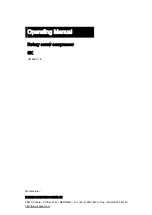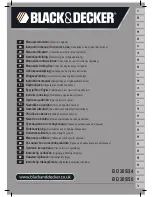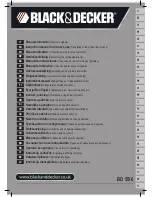
EN
- 10 -
or Rechargeable (Nickel Cadmium, Nickel
Metal Hydride, or Lithium-Ion) batteries.
6. Do not dispose of batteries in
fi
re.
7. Batteries should be recycled or disposed of
as per state, provincial and local guidelines.
When shipping or disposing of batteries and
cordless tools, always ensure that they are
packed individually in plastic bags to prevent
short circuits and
fi
res.
Safety information for the in
fl
ator/de
fl
ator
Danger! The following basic safety actions
must be taken when using this in
fl
ator/
de
fl
ator in order to protect the user from
electric shocks and the risk of injury and
fi
re.
Read and follow these instructions before
using the equipment.
•
Check the ambient conditions
Do not expose the inflator/deflator to rain.
Never use the inflator/deflator in damp or wet
locations. There is a risk of electric shock!
Provide good lighting. Do not use the inflator/
deflator near flammable liquids or gases.
There is a risk of explosion!
•
Protect yourself against electric shocks
Avoid bodily contact with earthed parts, e.g.
pipes, radiators, cookers and refrigerators.
•
Keep children away
Do not allow other persons to touch the
inflator/deflator or cable, keep them away
from your work area.
•
Do not use the cable for purposes other
than that for which it is designed
Do not carry the inflator/deflator by its cable
and do not use the cable to pull the plug out
of the socket. Protect the cable from heat,
oil and sharp edges. The cable/plug could
become damaged.
•
Take care of your inflator/deflator
Keep your inflator/deflator clean in order to
work well and safely. Follow the maintenance
instructions. Check the power plug and cable
on a regular basis and have them replaced by
an authorized specialist if they are damaged.
Check the extension cable regularly and
replace it if damaged.
•
Avoid unintentional starting
Make sure that the switch is turned off when
connecting to the power supply.
•
Check your inflator/deflator for damage
Before using the inflator/deflator again,
carefully check the safety devices and any
slightly damaged parts to ensure that they
are in good working order. Check that the
moving parts are working correctly, that they
do not jam, and that no parts are damaged.
Make sure that all parts are fitted correctly to
ensure that the equipment remains safe to
use. Unless otherwise stated in the operating
instructions, damaged guards and parts have
to be repaired or replaced by a customer
service workshop. Damaged switches have to
be replaced by a customer service workshop.
Never use an electric power tool with a switch
that cannot be turned on and off.
•
Leave all repairs to a qualified electrician
Repairs must be left strictly to qualified
electricians or the user might suffer an
accident.
•
Noise
Wear ear muffs when you use the inflator/
deflator.
•
Replacing the power cable
To prevent hazards, leave the replacement
of damaged power cables strictly to the
manufacturer or a qualified electrician. There
is a risk of electric shock!
•
Inflating tires
Directly after inflating tires, check the
pressure with a suitable pressure gauge, for
example at your filling station.
•
Place of installation
Set up the inflator/deflator on an even
surface.
•
WARNING! Risk of injury - Do not direct air
stream at body.
Safety instructions for working with
compressed air and blow-out pistols
•
The air which is sucked in by the deflator
must be kept free of impurities that could
cause fires or explosions in the deflator pump.
•
Wear safety goggles. Foreign bodies or blown
off parts can easily cause injuries.
•
Do not blow at people and do not clean
clothes while being worn. Risk of injury!
Safety information for paint spraying
•
Do not process any paints or solvents with a
flash point below 131°F (55°C). There is a risk
of explosion!
•
Do not heat up paints or solvents. There is a
risk of explosion!
•
If hazardous liquids are processed, wear
protective filter units (face guards). Also,
adhere to the safety information provided by
the manufacturers of such liquids.
•
The details and designations of the
Ordinance on Hazardous Substances, which
Anl_TE_AC_36_6_8_Li_OF_USA_SPK7.indb 10
Anl_TE_AC_36_6_8_Li_OF_USA_SPK7.indb 10
21.04.2022 12:54:40
21.04.2022 12:54:40











































